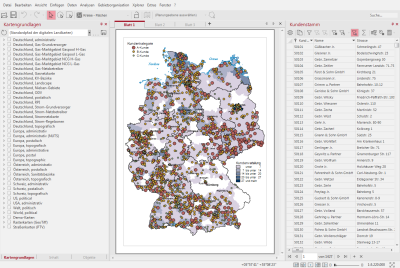Program Window
The program window consists of the menu, a toolbar, the control windows, scrolling and map windows, and one or more data windows.
Main menu
The main menu is displayed directly below the title bar and contains commands for opening the individual menus. More information on the meaning of the individual commands and functions can be found here.
The File menu summarizes all commands that refer to the entire workbook. It also contains commands to further process the workbook (expression, exports).
In the menu ? you will find access to our video tutorials and the example map folders. You can also find our Quick Start (Tutorial) here.
Toolbar
The toolbar below the main menu provides icon buttons for the most important commands in easymap. If you point with the mouse at an icon without clicking on it, easymap shows which command is assigned to the icon. Further buttons can be added or removed as required. To do so, right-click on the toolbar and select Customize... from the context menu.
A list of all symbol buttons and their meaning can be found here.
Control windows
In the program window, the control windows are located on the left in the standard view. The control windows allow quick access to the individual functions. The user can open the control windows with the corresponding commands in the menu Window. To switch between the different control windows, click on the tabs at the bottom of the control windows.
More information on the individual control windows can be found here.
Map window
The sheets of the easymap-workbook are displayed in the map window in the middle or to the right of the control windows. A new workbook contains an empty sheet and the possibility (the plus sign next to the sheet) to create additional sheets.
Which contents can be inserted into the map window can be found here.
Data window
Tables in easymap:
- After importing or linking external data and after creating a territory organization, easymap opens an additional data window. The external data is displayed in this window.
- Imported data can also be changed, deleted and supplemented here; in case of linked data, their processing is not possible in easymap, but only at the data source.
- Otherwise, the table offers different sortings and filters as well as a separate totals row, which can be switched between visible and invisible.
Status bar
The status bar is located at the bottom of the easymap screen.
- In the left part it informs about the processing progress (especially in case of extensive, longer lasting operations).
- Which object is currently selected is also indicated on the left.
- At the right edge it shows the coordinates of the current mouse position. If a sheet or an object that is part of a sheet is selected, the mouse position is displayed as the distance in cm from the upper left corner of the sheet. If a map or a level or an object within a map is marked, the mouse position is displayed in geographical coordinates.
- In addition, the status line shows the current view scale (if auto zoom is enabled) or the current map scale (if auto zoom is disabled).
- Here you will also find the selection of different arrangements of windows in quick access.
- The zoom slider allows you to zoom in or out directly on the sheet.
- You can precisely adjust the scale of your map by changing the scale or percentage, depending on the mark on the map or sheet, to the right of the zoom slider. To do this, click with the left mouse button on the percentage. A context menu opens with the possibility to enter the desired percentage or to change the map scale via the entry Setzen.... In addition, the functions View 1:1 like printout as well as the option to set the zoom directly to a mark made in the map are also located here.
- You can get the full view by clicking on the button
 on the far right in the status bar.
on the far right in the status bar.
Full screen mode
In full-screen mode, the screen is used for the map at most:
- The Windows taskbar disappears,
- the program window is maximized,
- the map window is maximized, control and data windows are hidden,
- the menu bar and status bar are hidden,
- the toolbar contains only the icons for zooming and highlighting;
- the tabs for selecting the map sheets are retained.
The full screen mode is mainly used for presentation purposes, as it does not offer any editing options. It is recommended to use the automatic zoom in connection with the full screen mode. This way you can ensure that easymap selects the map contents to be displayed according to the zoom level. As data tables are hidden in full screen mode, we recommend the use of tooltips for analyses. If tooltips are activated, easymap shows the selected data when moving the mouse over the map contents.
The full screen mode is activated with the corresponding command in the menu Window or with key F11. It can be deactivated by pressing F11 or Esc or by clicking Close in the toolbar.

